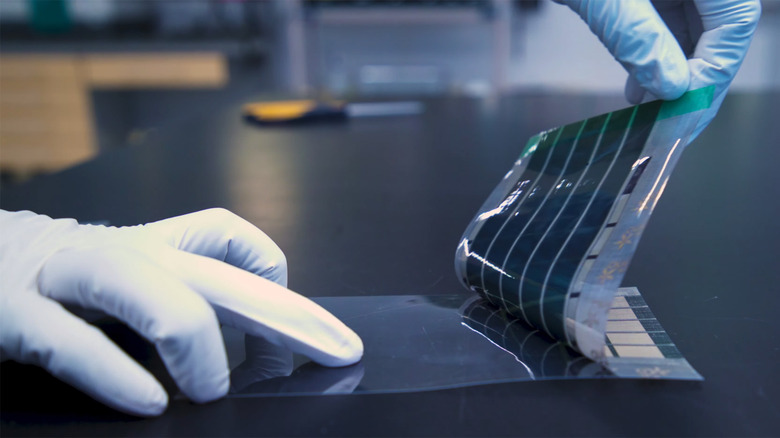These Ultra-Thin Solar Cells Can Be Glued To Any Surface And Produce Incredible Power
Ultra thin solar cell panels are being researched at a staggering pace, and the promises are seemingly endless. Now, the folks over at the Massachusetts Institute of Technology have developed a new ultra-thin, organic photovoltaic solar cell that can be pasted like a sticker on any surface to generate power. Plus, they are extremely efficient, producing 18 times as much power per kilogram compared to conventional thick film solutions.
Instead of glass, the team used vapor-deposited parylene as the substrate material, which also offers the benefit of being easy to manufacture at a mass scale. For creating the photovoltaic films, the team used a UV curing adhesive to laminate the photovoltaic devices on a layer of Dyneema Composite Fabric, which is extremely light, but quite sturdy. During tests, this flexible and paper-thin solar panel retained over 90% of its efficiency after 500 rolling and unrolling cycles. Interestingly, MIT experts similarly made a solar film light enough to sit above a soap bubble a few years ago.
As per the research paper published in the Small Methods journal, the entire fabric-based solar cell system is just about 50 micron in thickness, less than the average thickness of human hair. When compared against a regular solar cell panel, these experimental photovoltaic cells are roughly a hundred times lighter too, while also surpassing them at power generation. In 2021, experts at German company named Heliatek did a similar experiment by pasting flexible ultrathin organic solar films over a water tank and produced encouraging results.
Light, bendy, and mighty efficient
The biggest benefit, however, of these screen-printed solar cells is that they can be fixed to any surface, letting it harness the Sun's energy and converting regular objects into a power generation source. The team behind it proposes that these cells "could be integrated onto the sails of a boat to provide power while at sea, adhered onto tents and tarps." In fact, these can also be plastered over the wings of drones to boost their range, without disrupting their fickle aerodynamic efficiency. Talking about drone range though, the folks over at Defense Advanced Research Projects Agency (DARPA) are funding a tech called Whisper Beam that will charge drones mid-air using a focused beam of radio waves.
Circling back to the amazing work with solar cells that is being accomplished at MIT, the whole idea is to make the photovoltaic power generation tech easy to install, without any cost or expertise hassles. Scalability is another core issue that these solar cells address. Compared to traditional solar cells that rely on metal frames and glass casing, these ultra-thin cells can be printed using ink-based materials. The electronic ink needed in this case includes nanomaterials and it essentially uses the same technique as "silkscreened T-shirts."
Talking about the mass-energy efficiency figures here, the team says 20 kilograms worth of their flexible solar cells will be enough to generate 8,000 watts of electrical power, which sounds absurd compared to the hefty weight of a typical solar cell installation.
